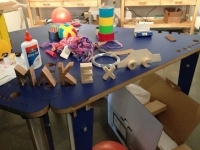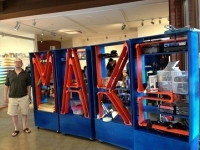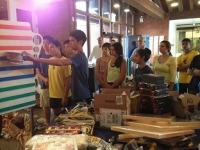makeX: Palo Alto Teen Mobile Makerspace Project
Palo Alto City Library, Calif.
Innovation Synopsis
makeX, a collaboration between Palo Alto City Library and Palo Alto Art Center, funded with a $67,500 grant from the California State Library (in-kind costs and donations total close to $100,000) resulting in a teen-designed “starter” mobile makerspace able to move to libraries and community centers throughout Palo Alto.
Challenge/Opportunity
While Palo Alto, including the Art Center and the Library, has a long tradition of community collaboration supporting youth and teens, a tragic spate of teen suicides in recent years galvanized the community to strengthen efforts to develop strategies to address teen issues and help teens thrive. Parents in the community have identified the need for opportunities to engage in extracurricular activities that promote creativity, offer opportunities for expression, and relieve stress. Youth health and well-being is a Palo Alto City Council priority and is supported through a variety of resources. One of these, Project Safety Net, whose mission is to develop and implement an effective, comprehensive, community-based mental health plan for overall youth well-being in Palo Alto - was an active resource partner for this project. The framework for Project Safety Net is the 40 Developmental Assets, developed by the Search Institute, and used in public libraries throughout the country. Both the Art Center and the Libraries have recently been involved in capital campaigns which have renovated and changed the available spaces to accommodate community needs. The Art Center found that: Teens need a safe and fun place to actively express themselves with their friends because it is important to be involved in a community in which you are heard and respected. The Library did not have space during construction, so a collaboration began.
Key Elements of Innovation
Key elements combined teens as designers of a makerspace which would be able to change sites for better access, using a design thinking approach for creation. Began with project introduction, contextualizing the makerspace movement, discussing goals, and developing ground rules for the project with 22 teens, a mix of paid consultants and volunteers, who made clear they didn’t want to be called teens, so we brainstormed and decided upon “designers.” Following a pre-survey to ascertain the participating teens’ familiarity with makerspaces and design thinking, learned approximately half the teens were not familiar with design thinking and 15 had never used a makerspace. We visited the Bourn Idea Lab at Castelleja school (Palo Alto), the Stanford Fab Lab, the Crucible (Oakland), the Exploratorium (San Francisco), and TechShop (San Jose). Designers interacted with and asked questions of the staff. We also visited Hero Design (Oakland), who fabricated furniture the teens designed for makeX (their name choice).
Art Center staff facilitated a design thinking project, using materials from the Stanford D School:
- empathy process: interviews with peers about interests and hobbies.
- define phase: teens created their problem/experience statement in groups.
- brainstorm: using experience/problem statements, brainstorm responses for space, identify equipment and materials to buy; learning experiences for the space, rules for use, and a schedule.
- prototyping: using simple art supplies, designers created models, first small, then with large-scale corrugated sheets in full size/3-D: seating, storage, display, and partitions, which were tested by makerspace managers.
Documented prototypes were translated into drawings Hero Design used for fabrication. Furniture was delivered and installed at the Art Center. makeX opened at the Art Center on August 31, 2013.
Achieved Outcomes
To design and develop a third space for Palo Alto middle-school and high-school age teens that is a “space of their own” that promotes self-directed and mentored creative expression and learning about art and technology, meets the educational and social needs of the teen audience and through its mobile nature, encourages participation by teen audiences throughout the City. To involve teens extensively in the planning process in a manner that will promote their engagement in the design thinking process and demonstrate the applications of design thinking concepts in life and learning. To create an environment in which teen voices are heard, validated, and used to determine the final design. To contribute to the City of Palo Alto’s overall goal of improving the well-being of young people by expanding programming for teens by the Art Center and City Library. To contribute to the City of Palo Alto’s City Council priority of “Technology and the Connected City.” To create, prototype, and model a project that can be replicated throughout libraries and museums.
Majority of teen designers shared that they thought they could incorporate design thinking in their day-to-day lives:
- “Yes, design process could be applied to problem solving and other critical thinking applications.”
- “Problem solving skills apply to all problems—abstract and physical.”
Our educational consultant on the project, Bernie Trilling, sees this project as the only one of its kind in the country in which teens drove the design and production of a makerspace for teens.



